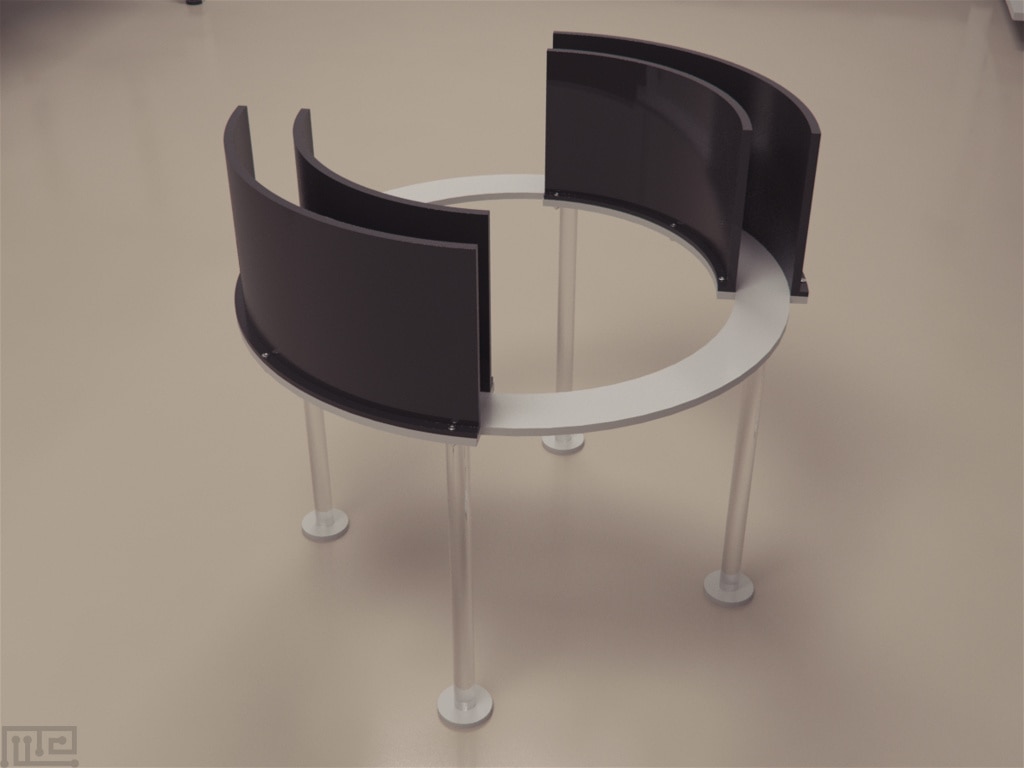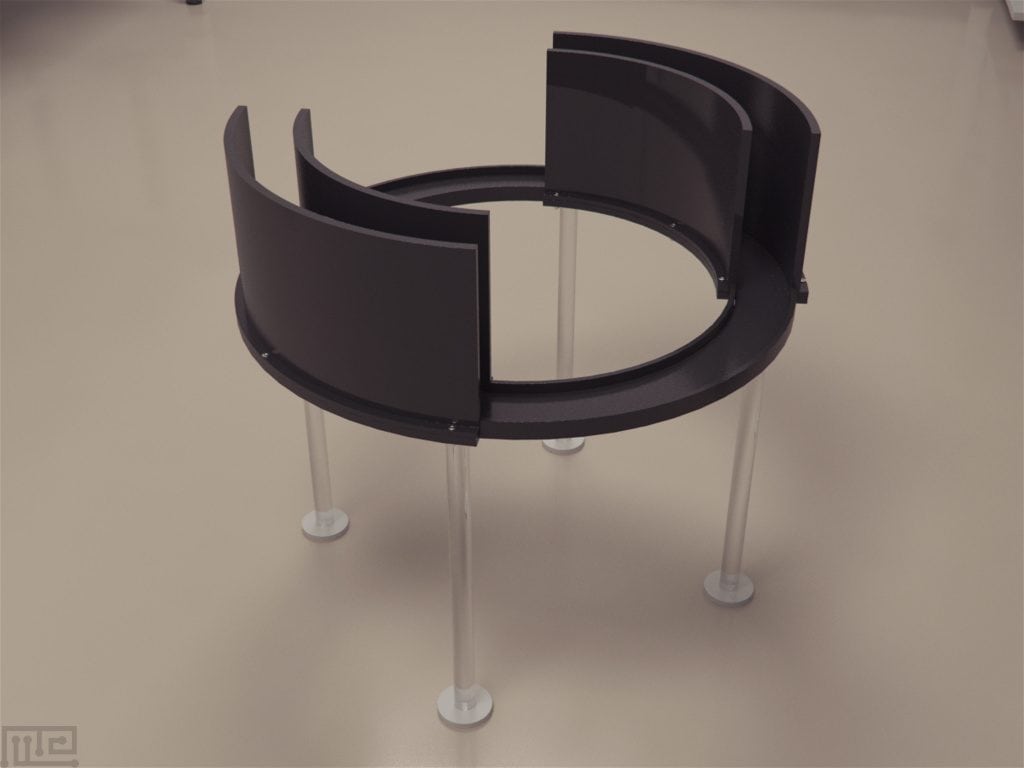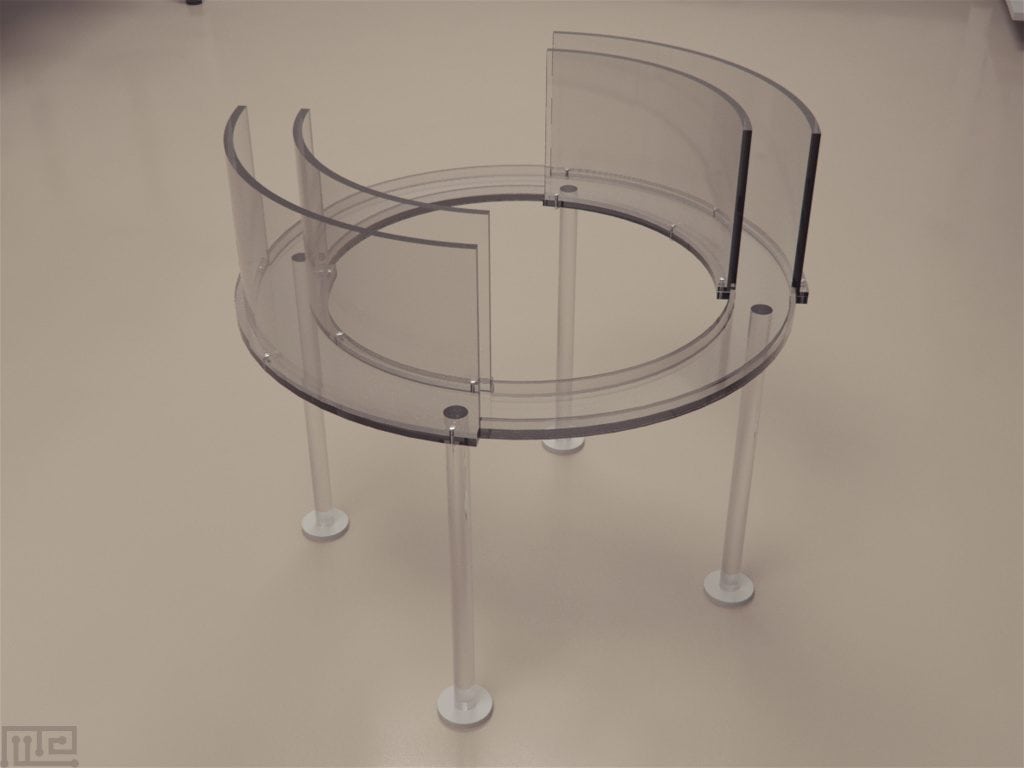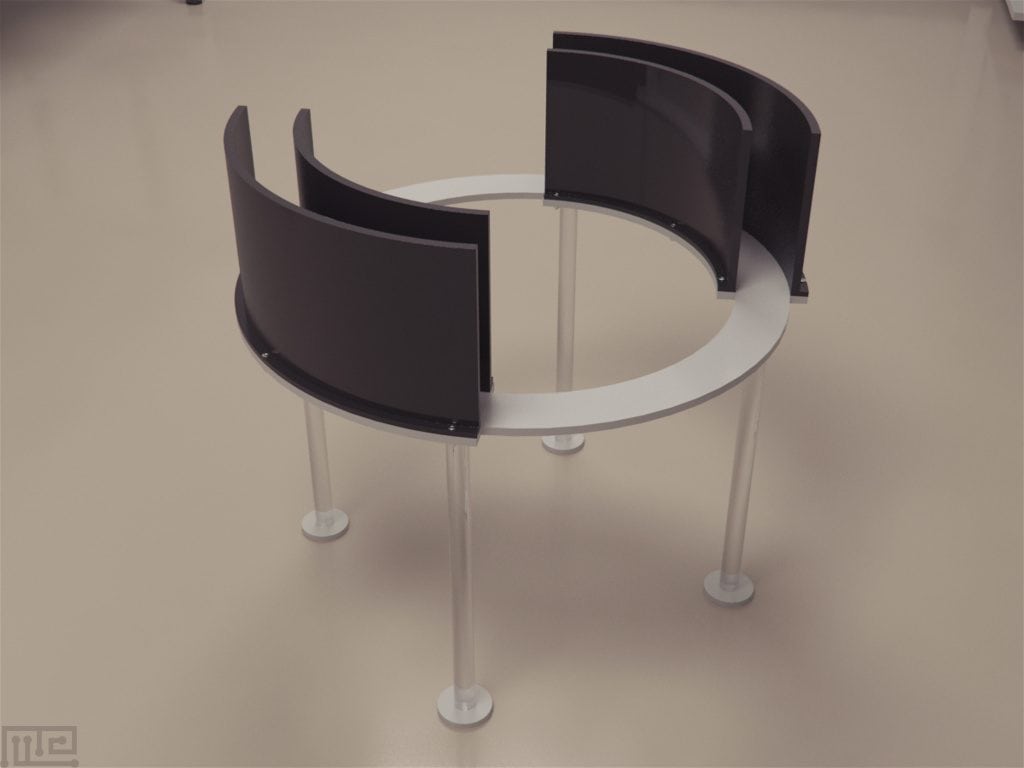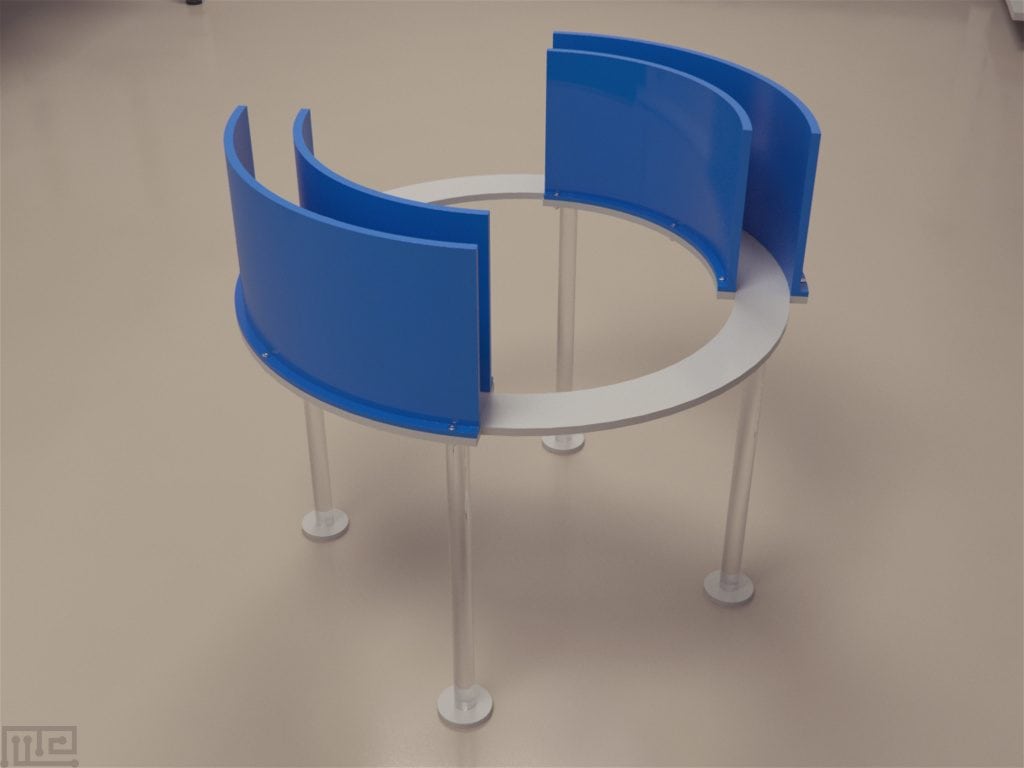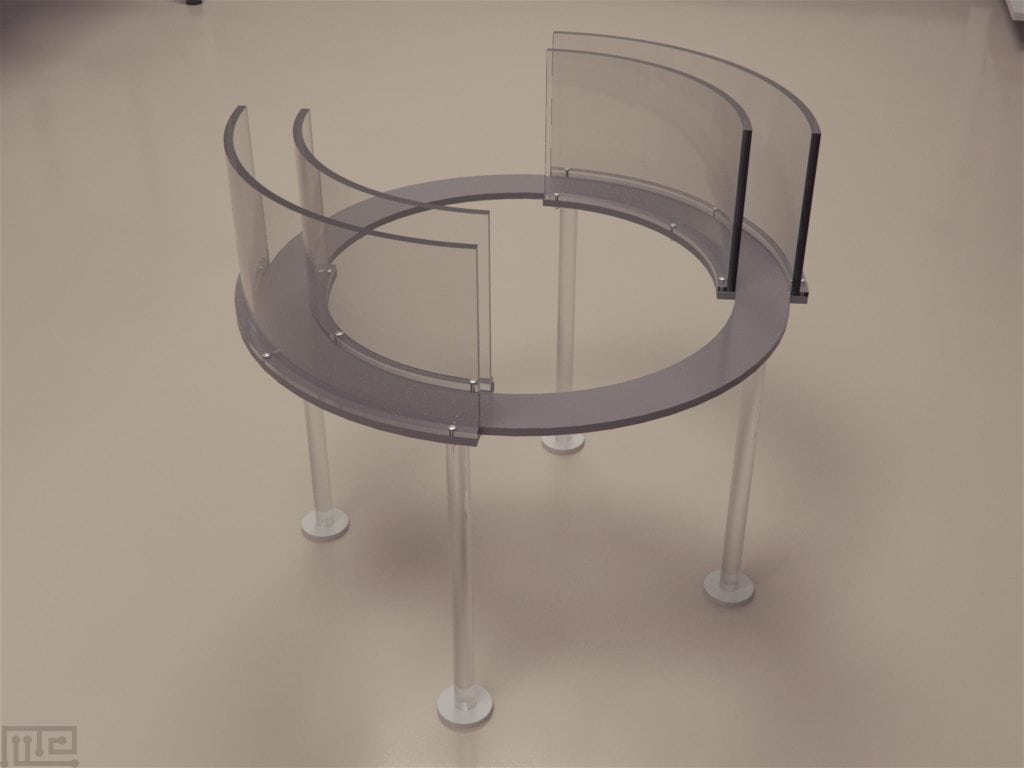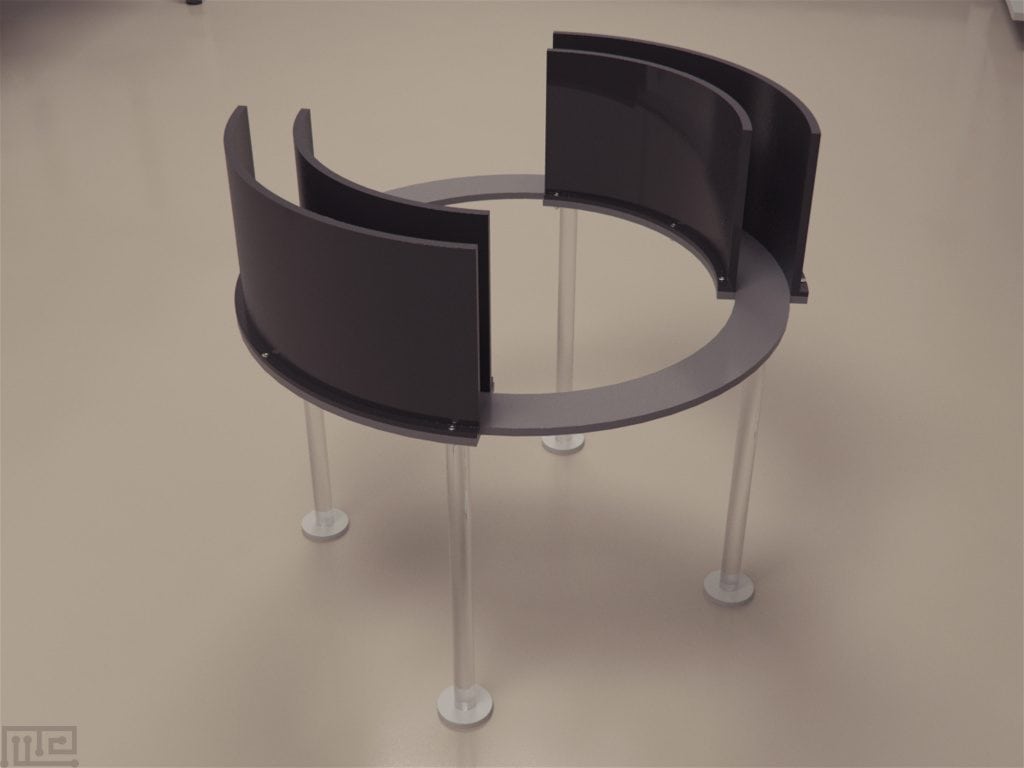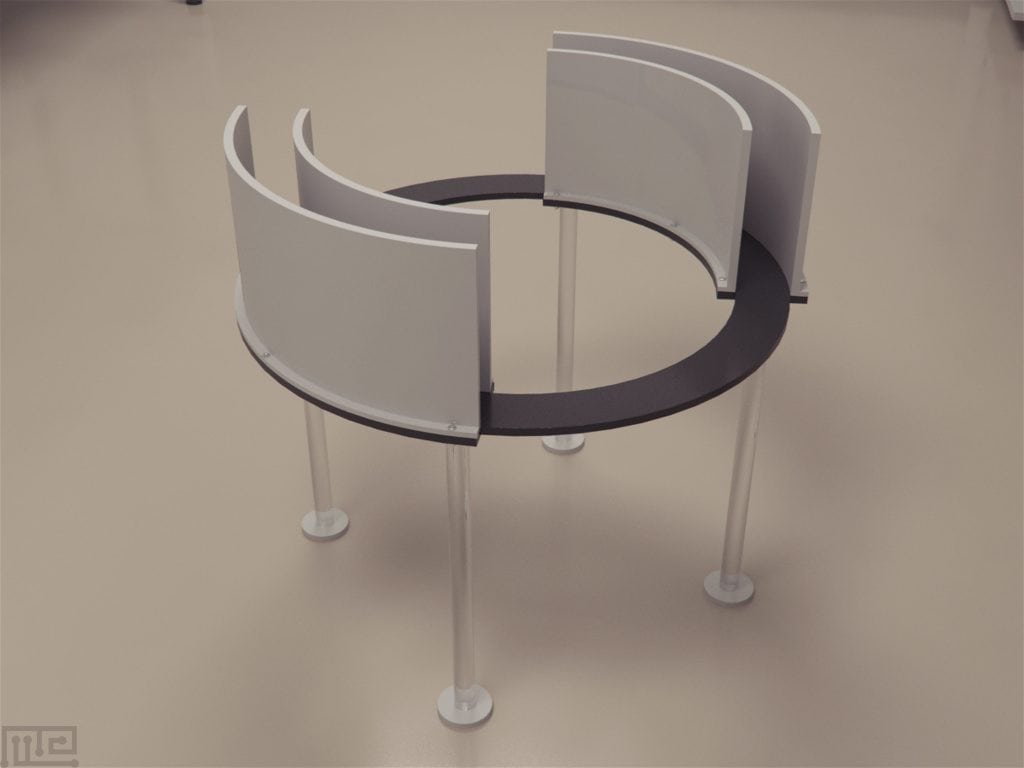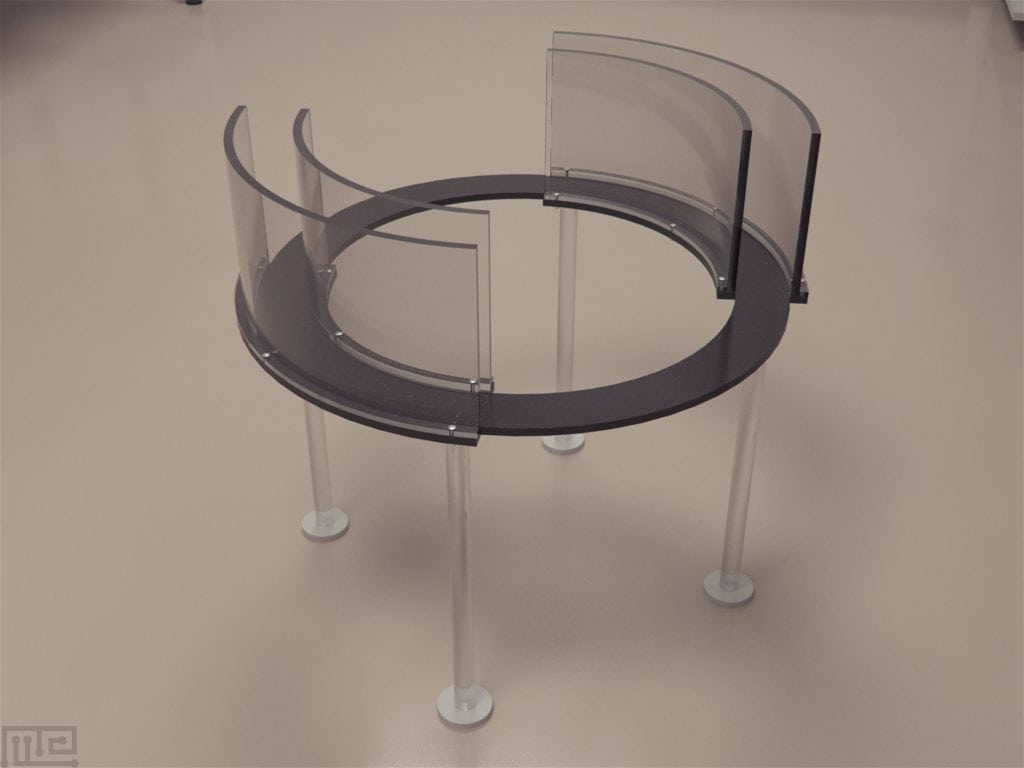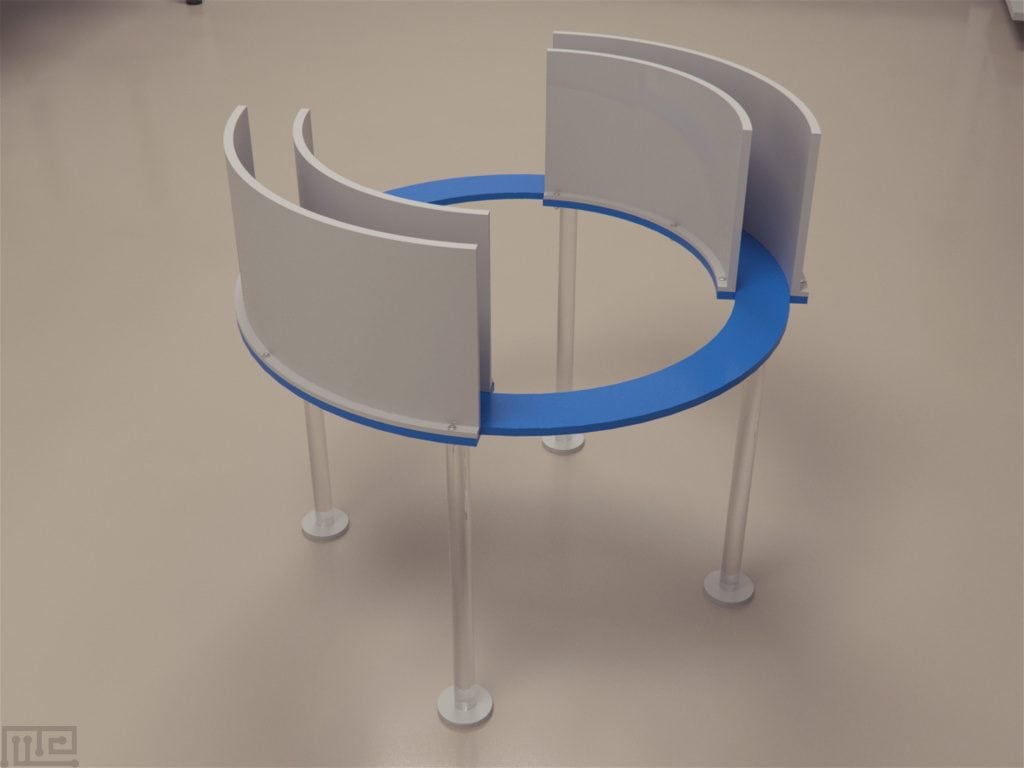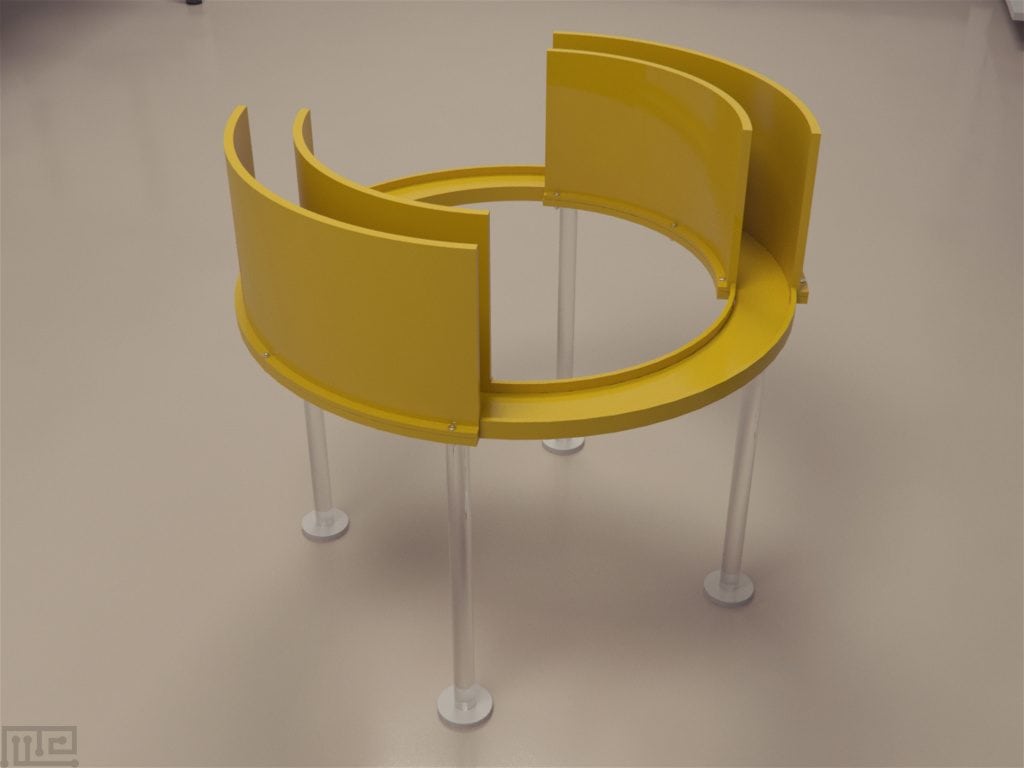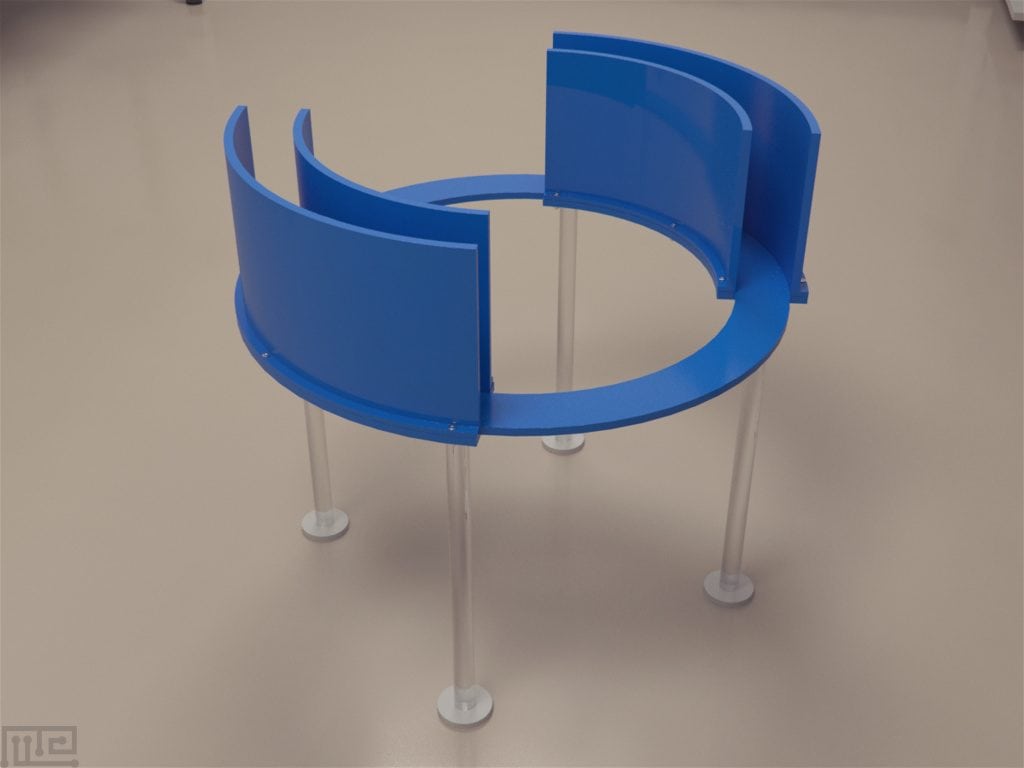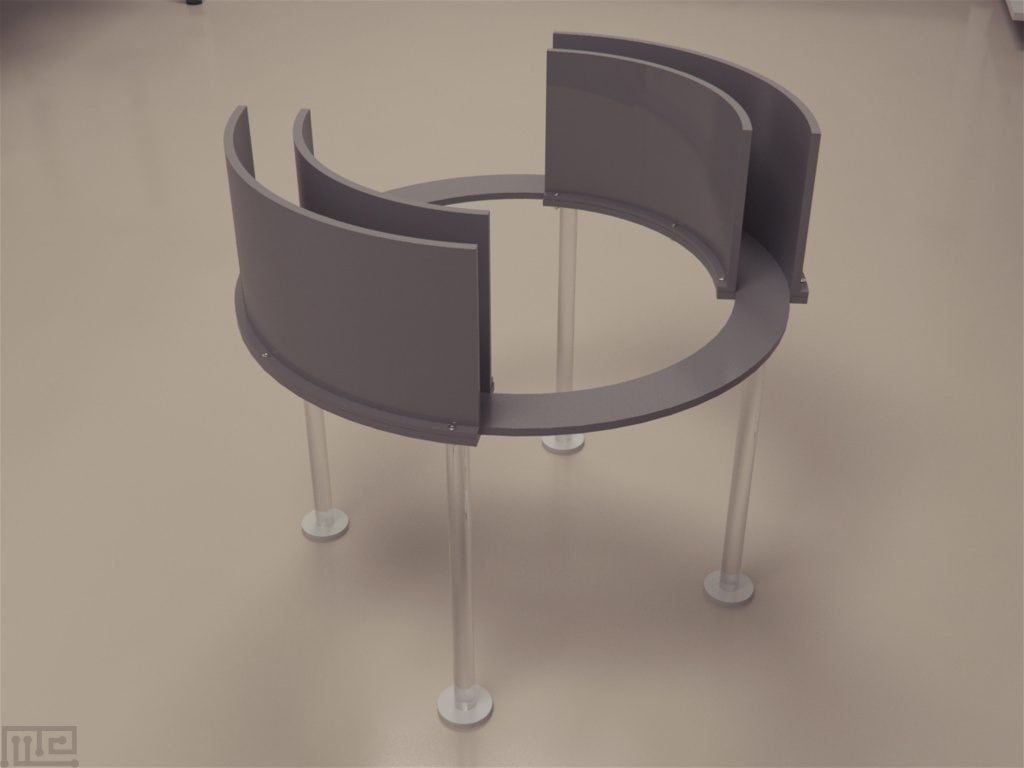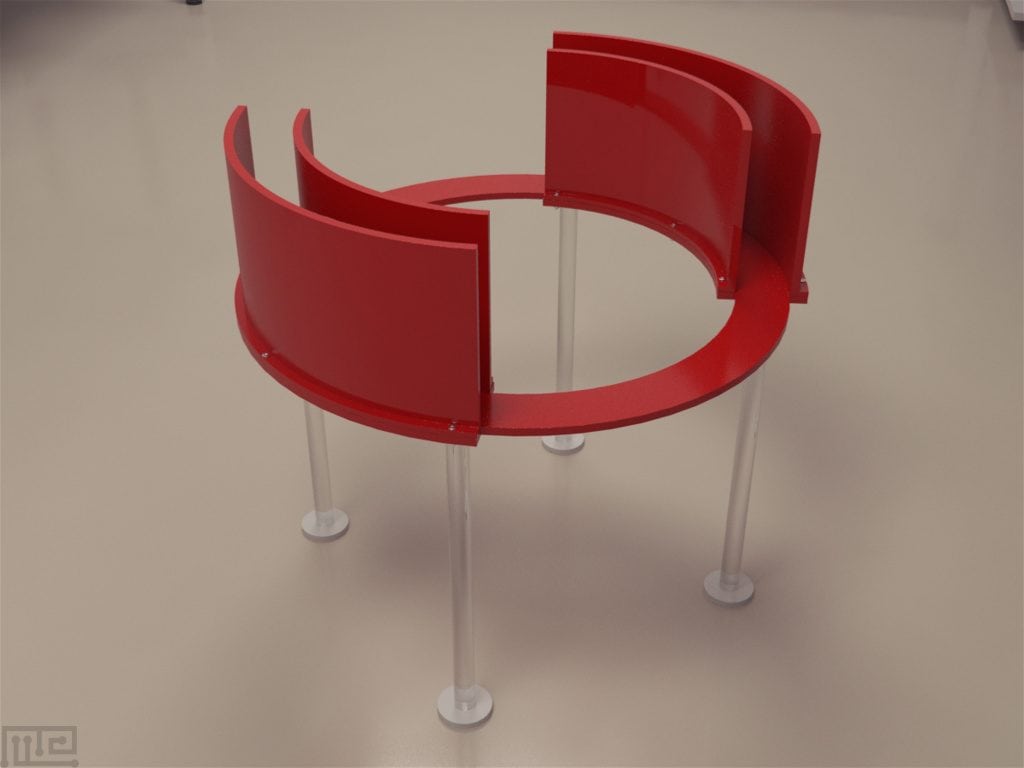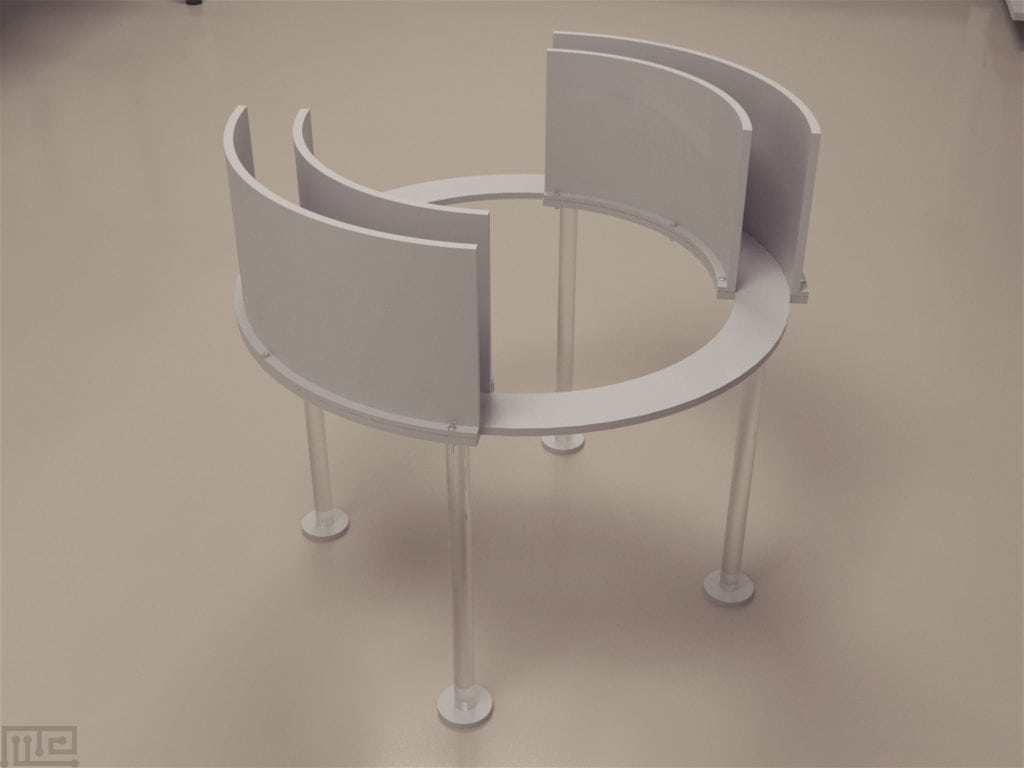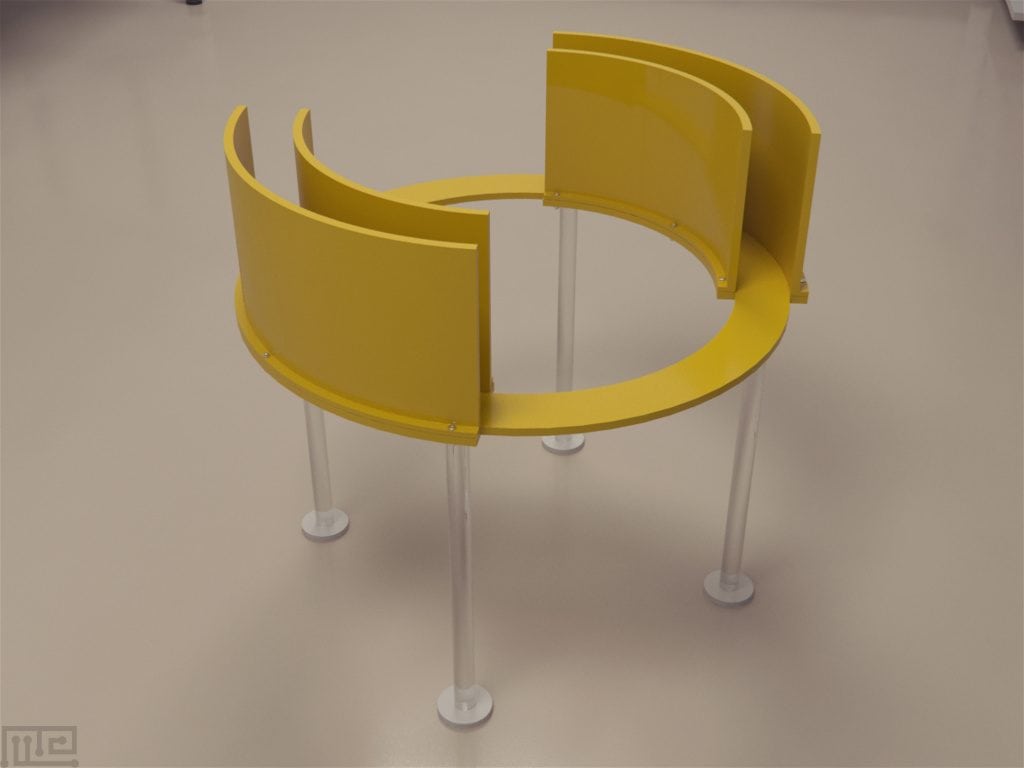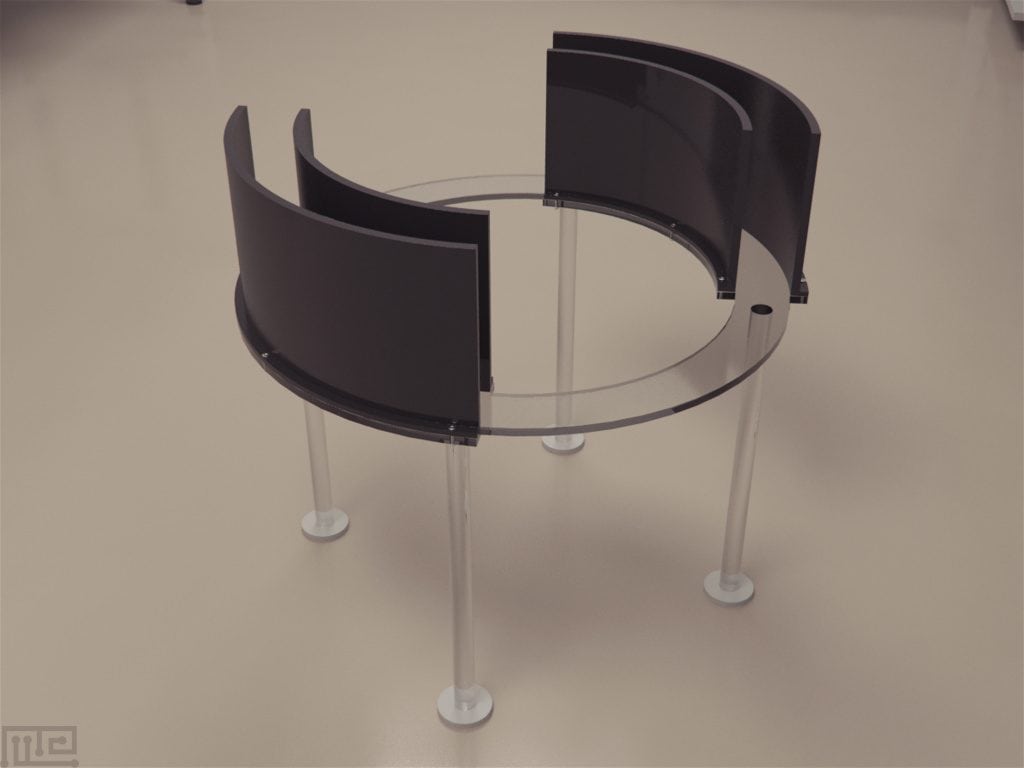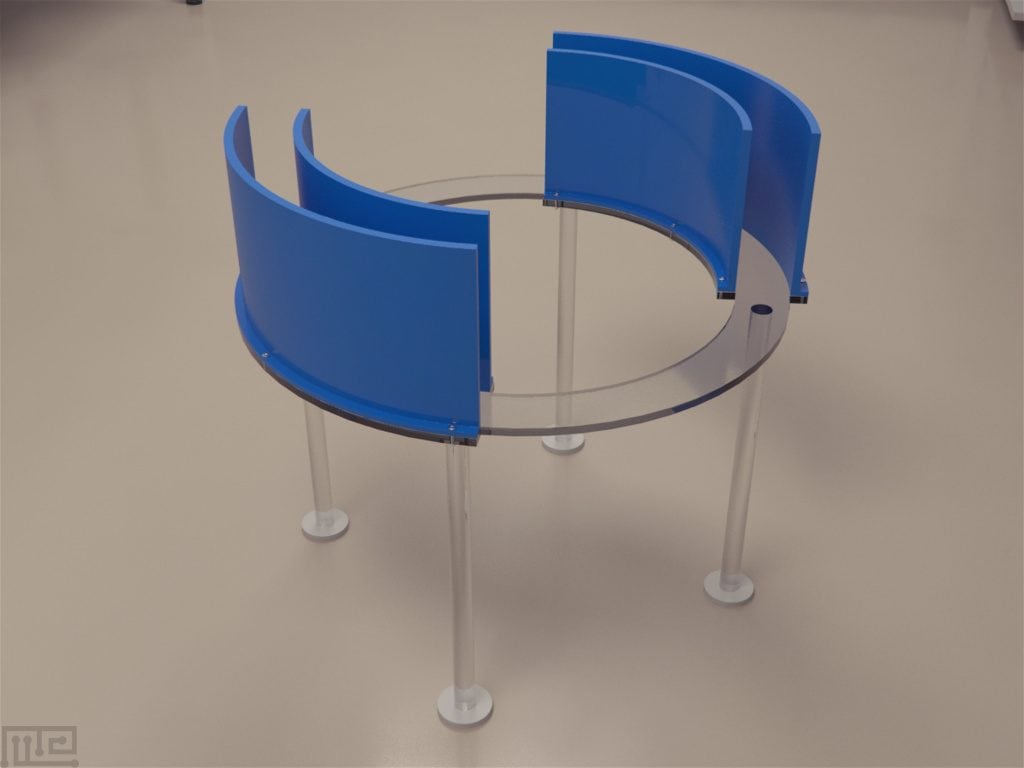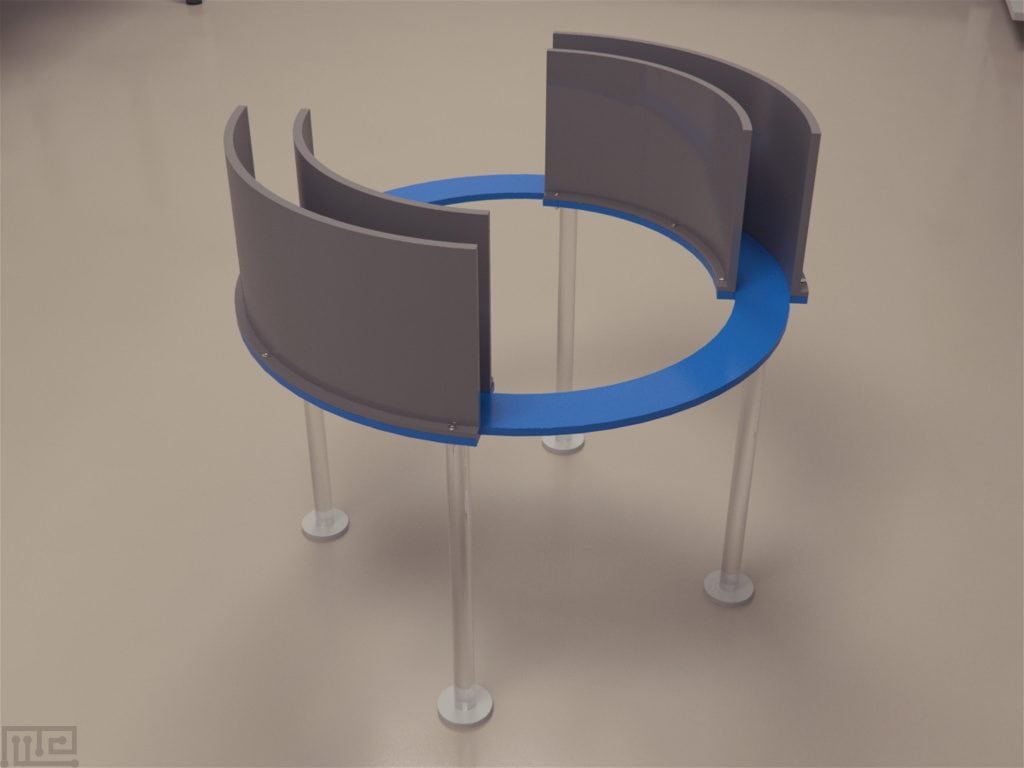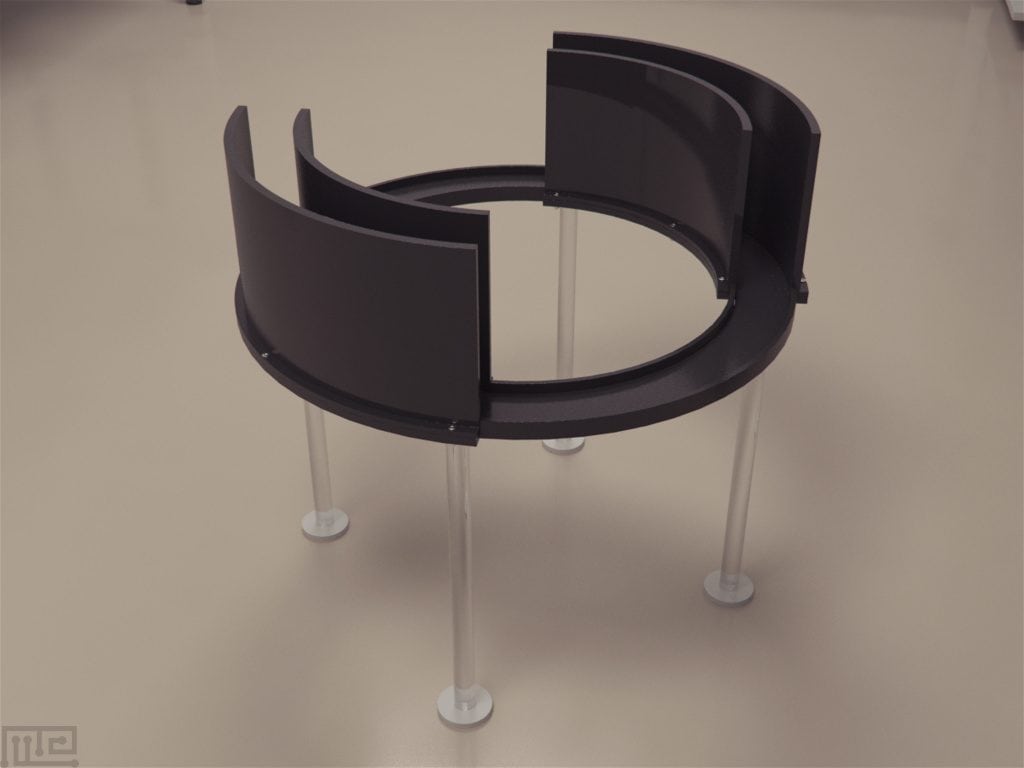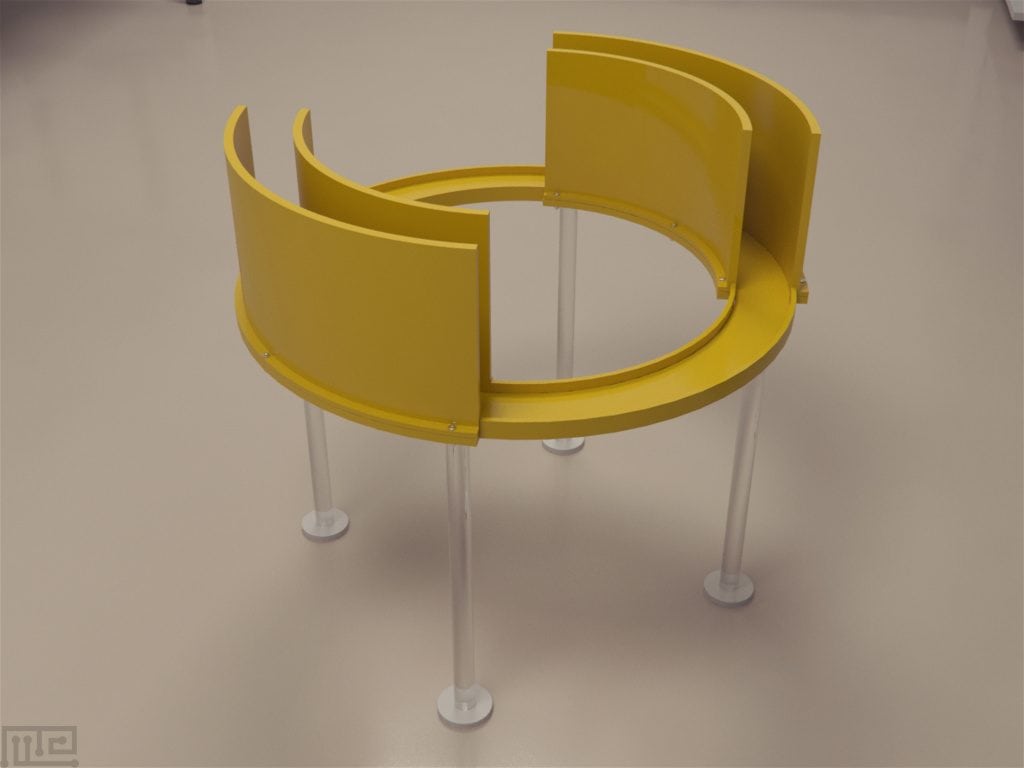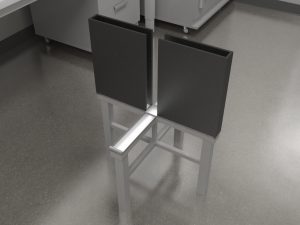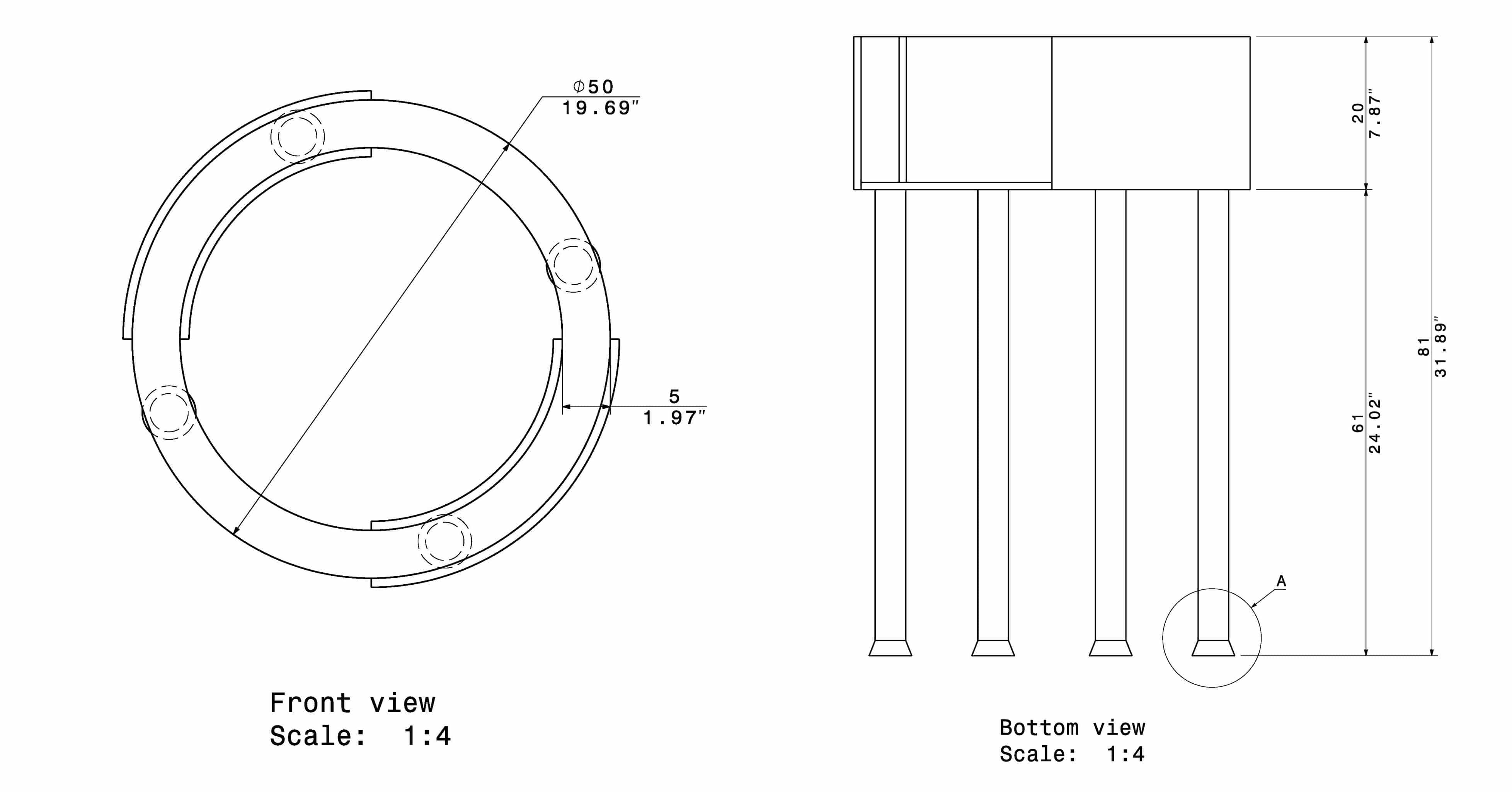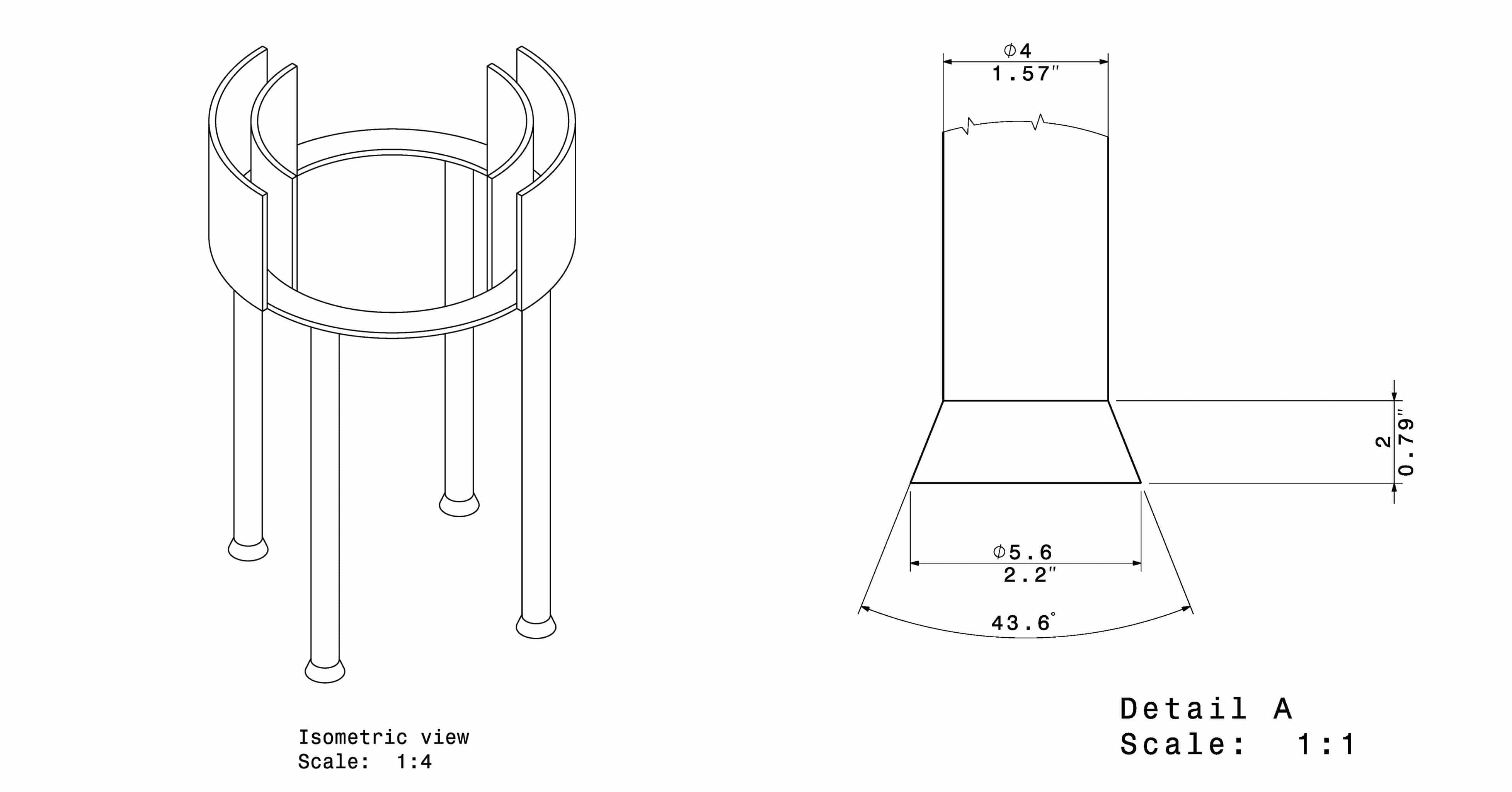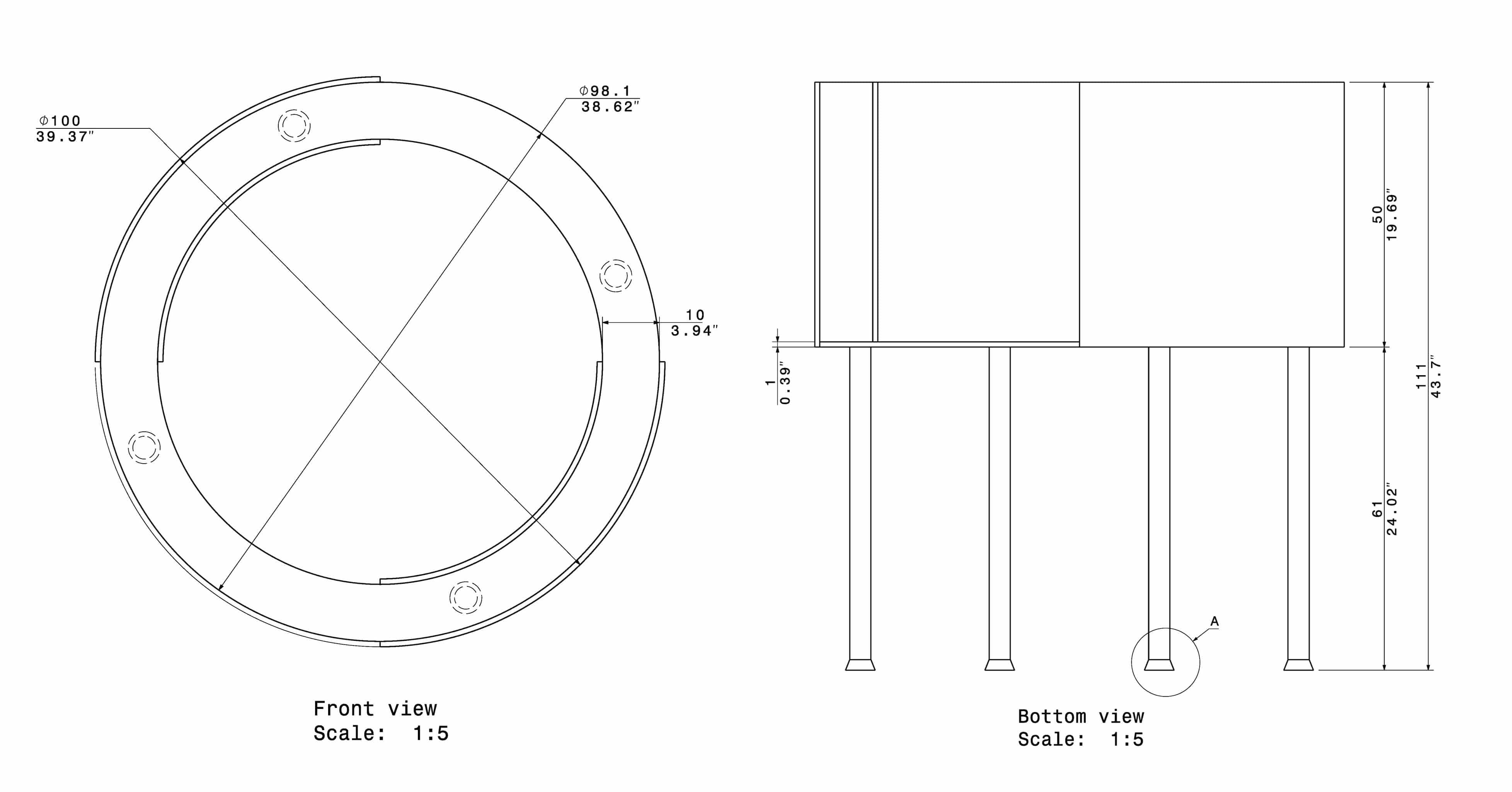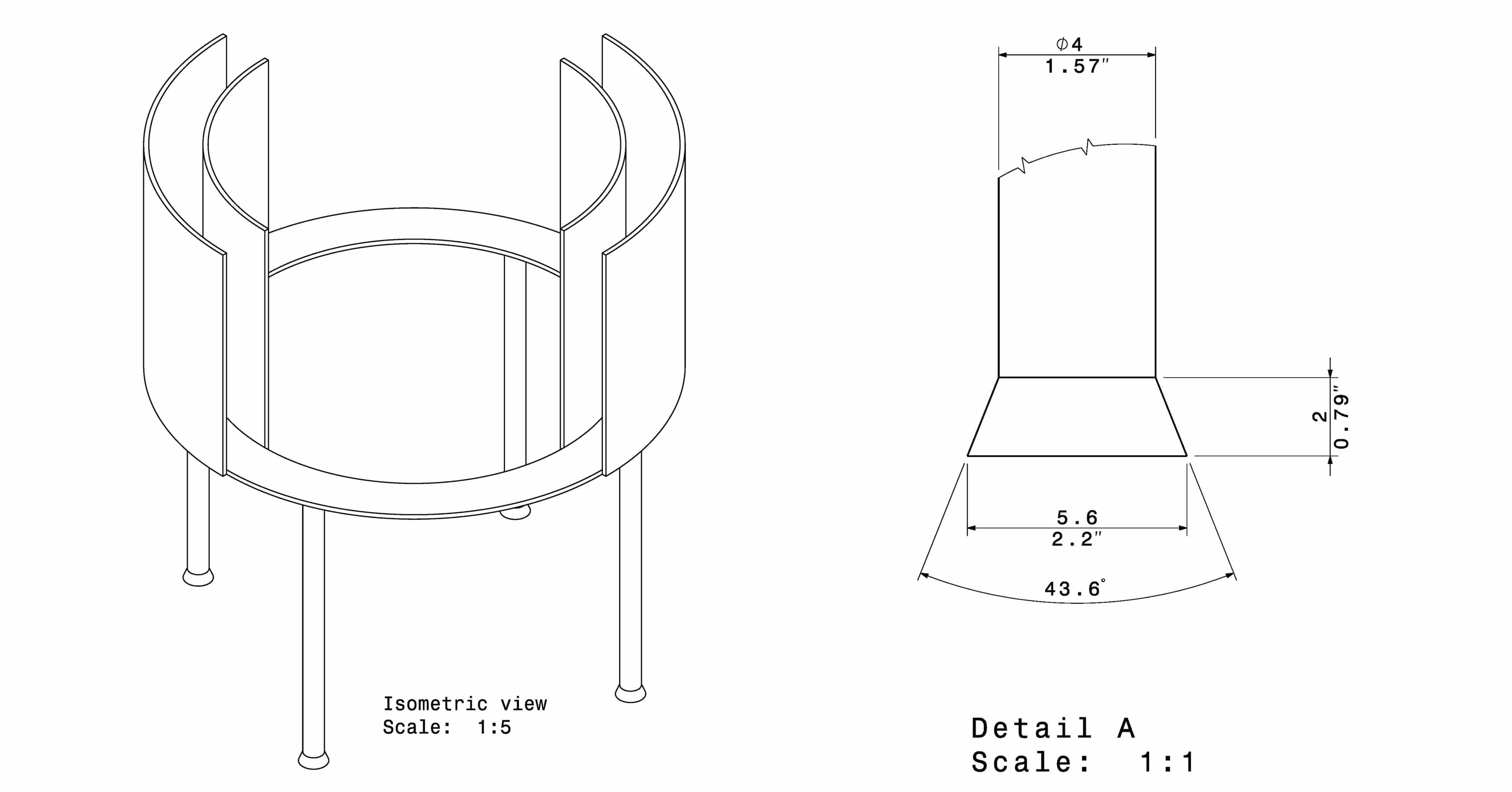The Elevated Zero Maze is an elevated ring-shaped runway with the same amount of area devoted to adjacent open and closed quadrants, with increasing usage in recent years. It is very similar to the elevated plus maze, but with the center region of the elevated plus maze removed. It has been pharmacologically validated with various anxiolytic drugs.
The design is created with an elevated circular platform with two walled, enclosed portions as well as two open portions, allowing for clear interpretations of murine behavior. Because mice tend to avoid open-spaced areas, the animals will preferentially spend more time in the enclosed walled area.
Mouse
$ 1890
+ Shipping and Handling (approx $200)- Acrylic
- No Odors
- Matted for non reflective surfaces
- Easy clean with 70% Ethanol
Rat
$ 2290
+ Shipping and Handling (approx $300)- Acrylic
- No Odors
- Matted for non-reflective surfaces
- Easy clean with 70% Ethanol
Doors (<4)
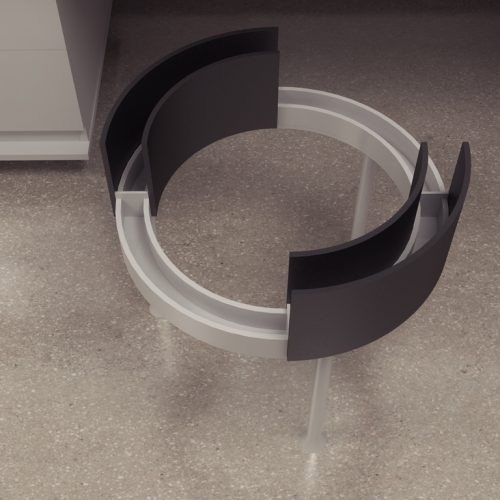
Dimensions: To fit
Cost $100
Additional Height of Walls
Used for Mouse
Dimensions: 40cm wall height
Cost $200. Shipping approx. $100
Additional Height of Walls
Used for Rat
Dimensions: 50cm wall height
Cost $250. Shipping approx. $150
See our similar products
Elevated Zero Maze (EZM) is an adaptation of the Elevated Plus Maze (EPM) that combines both classical and new ethological measures. The maze has been gaining steady popularity as a behavioral assay for anxiety-like behaviors. It takes advantage of a rodent’s innate preference for dark, enclosed spaces as opposed to open spaces. Unlike the EPM, the EZM subjects the participant to a continuous circuit that has alternating walled and un-walled areas.
The maze was developed based on the principles of Montgomery (1955) experiment that used an elevated Y-Maze with one of the choice arm enclosed to mimic a safe space and the other choice arm left un-walled. The Elevated Zero Maze was developed (Shepherd 1992, Shepherd et al.,1993) and pharmacologically validated for anxiety-like behaviors in mice by Shepherd and colleagues in their paper published in 1994. The maze has since seen a growing interest as a better alternative to the Elevated Plus Maze.
The Elevated Zero Maze consists of a circular track that is elevated above the ground and divided into four quadrants. Alternating segments (quadrants) of the alleyway are enclosed by dark walls while the rest remain open. The EZM eliminates a choice point as seen with the EPM thereby removing the ambiguity associated with a central arena.
History
Origin
The Elevated Zero Maze was first described by Shepherd (Shepherd 1992). It was designed to overcome the issue of the Elevated Plus Maze. The EPM’s central platform, which served as the choice point for the subject to choose one of the four arms, resulted in difficulty in interpretation of the time spent in that area. To overcome this ambiguity presented by the EPM, Shepherd designed a circular maze with alternating enclosed and open areas.
The pharmacological validation of the Elevated Zero Maze was done by Shepherd and colleagues in the preceding papers (Shepherd et al.,1993, Shepherd et al.,1994). The apparatus showed great success as an animal model of anxiety and proved to be a more sensitive test in comparison to the EPM.
Developments
Matto et al. used the EZM to evaluate the effects of cholecystokinin A and B receptor agonists SR 27897 B, devazepide, L 365260 and PD 135158 (CAM 1028) on exploratory behaviors of rats. Their experiment was able to support the involvement of CCK(B) receptor subtype in the neurobiological mechanisms of anxiety.
The differential effects of beta-carbolines and antidepressant were explored by Pähkla et al. In their paper, they compared the antidepressants desipramine and fluoxetine with anxiogenic beta-carboline DMCM. They further tested pinoline in comparison to DMCM and the antidepressants. The results of their investigation suggested that in comparison to the antidepressants both pinoline and DMCM decreased the time spent in open spaces, the number of line crossings in the open spaces and the number of head dips. They were able to conclude that mechanisms other than serotoninergic in nature were involved in the action of pinoline.
mGlu1 receptor blockade’s effect on anxiety-like behaviors in rats was tested by Steckler et al. Doses of up to 10mg/kg IP of JNJ16259685 showed to have no anxiolytic effect on the performance of the rats on the Elevated Zero Maze. However, on treatment with lowest active dose (5mg/kg) of benzodiazepine chlordiazepoxide a relative increase in time spent in open spaces was observed.
Recent Developments
Using mice deficient in either mGlu4(-/-) or mGlu8(-/-) or both receptors mGlu4/8(-/-) the possible relation and overlapping of functions of the mGlu4 and mGlu8 metabotropic receptors was analyzed by Davis et al. When subjected to the Elevated Zero Maze, mGlu4 deficient mice spent more time in open areas of the maze in comparison to the other groups. However, no genotype difference in activity levels was observed for any of the groups.
The anxiety-like behaviors of APP/PS1 mice were tested using the EZM in their investigation by Biallosterski et al. The mice were subjected to the EZM after voiding behavior testing, and it was observed that the APP/PS1 mice showed a lower preference for open space as compared to the wild-type mice that spent significantly more time in the open sectors.
Tucker et al. tested C57BL/6J mice in the EZM after controlled cortical impact (CCI) to investigate the anxiety-like symptoms following a traumatic brain injury. In their investigation, they observed that CCI reduced anxiety-like behaviors and fewer anxiety-like behaviors were associated with the female sex.
Apparatus and Equipment
The Zero Maze is composed of a circular alley of diameter ranging from 40 to 110 cm and having a width in the range 50 to 10 cm. The alleyway is divided into four equal quadrants. Each of the opposite quadrants is walled with approximately 30 cm high, dark-colored walls to create an enclosed space. The remaining two quadrants are bordered with an approximately 5mm rim in order to prevent the subject from falling off the track, and these quadrants serve as the open anxiogenic spaces. The apparatus is raised above the floor to a height of at least 70 cm.
To avoid shadows and to ensure equal lighting in all the quadrants, the EZM should be lit from above. Proper lighting also ensures that the subject is able to see the food rewards or other cues if used. Video tracking software, such as Noldus Ethovision XT, mounted above the maze can assist with live scoring and tracking and recording the subject and its movements within the maze. The apparatus must be cleaned thoroughly before and after each trial to limit influence from any residual stimuli from previous trials.
Training Protocol
The Elevated Zero Maze’s continuous alley design serves as a more sensitive maze than the Elevated Plus Maze and thus is employed in the assessment of anxiety and anxiety-like behaviors. Like the EPM, the EZM also utilizes the subject’s preference for open spaces as a way to assess the performance of the treated group or the disease group in comparison to a control group.
Rodents have an innate preference for closed or enclosed spaces where they feel safe. Thus they tend to avoid exploring exposed alleys as much as the enclosed ones. Animals treated with anxiolytic drugs show reduced anxiety-like behavior and are more likely to explore the exposed areas of the maze. On the other hand, animals treated with anxiogenic drugs tend to spend less time in open spaces and more time exploring the enclosed areas due to the heightened anxiety-like feeling. The amount of time the animal spends on either of the areas provides information regarding the anxious state of the subject.
The maze as such requires no pre-training as the task is intended to test the response of the subject to an unfamiliar maze. Before every trial, the apparatus must be thoroughly cleaned with a solution of ethanol to avoid the influence of residual stimuli if any.
Evaluation of Anxiety-like Behaviors in the Zero Maze
The subjects are brought into the testing area at least 1 hour prior to the testing. During the sessions, it is important to ensure all the lighting level are consistent and do not inhibit exploratory behaviors.
The video recording is started (if being used) and the subject is placed in the center of the enclosed alley and allowed to freely explore the maze (Some investigations place the subject in the center of the open area). Each testing session lasts for at least 5 minutes after which the subject is carefully removed from the maze and placed in its home cage. The recording is also stopped at the expiration of the 5 minutes.
Trials are repeated for each subject for over a period of about 3 days.
Modifications
The Elevated Zero Maze has seen minimal variation in its general apparatus design since Shepherd’s initial design; however, it has been adapted for different laboratory animals. Although design modifications are yet to be seen, simple modifications such as using transparent walls and changing the length or frequency of the enclosed arenas could have potential in investigatory processes involving the EZM.
Most of the published modifications utilizing EZM have been with the use of different strains of rodents. Different strains of mice tend to exhibit significantly different behaviors in the maze, or differences in the statistical analysis. (Biallosterski et al.,2015; Tucker et al.,2017)
The EZM has also been frequently used in determining the role of gene modifications and analyzing effects of pharmacological substances. (Heredia et al.,2012; Wilking et al.,2012; Davis et al.,2013).
Data Analysis
Similar to the Elevated Plus Maze, the variables measured during the Elevated Zero Maze task include
- Percentage time spent in the open areas
- Percentage time spent in the walled areas
- Latencies to enter the open spaces
- Total time spent in open and closed areas
- Total distance traveled
Other observable measures include,
- Risk assessment behavior calculated by analyzing the frequency and duration of sniffing from inside the closed area. (Schulz et al.,2011)
- Reduced level of anxiety by assessing the number of head dips over the edge of the open area. (Rodgers & Dalvi 1997)
General activity is determined as the number of entries into closed spaces. Subjects spending shorter intervals in the open spaces are translated as increased anxiety (Pellow et al.,1985). Behaviors associated with reduced anxiety, such as head dips and stretch attend postures, tend to increase in animals treated with anxiolytic drugs.
Using graphs allow for easy comparison among animals treated with anxiety-reducing drugs and the sham control group. Animals treated with saline are naturally cautious of open, exposed areas and tend to have higher latency times, as well as a decreased percentage of time spent in open areas. Those animals treated with anxiolytic drugs, such as diazepam and chlordiazepoxide show decreased latencies and a higher percentage of time spent in open areas. These animals will also likely display fewer anxiety-related behaviors, such as stretched attend postures. Generally, animal cohorts of approximately 10 animals are sufficient to obtain p-values of <0.05 using a 1-way ANOVA, ANCOVA, or post hoc tests (Shepherd et al.,1994, Cook et al.,2002, Braun et al.,2010, Heredia et al.,2013).
Translational Research
The Elevated Zero Maze overcomes the difficulty that arises in Elevated Plus Maze in evaluating the biological significance of anxiety-related behavior due to the ambiguous central platform. Further, the EZM has a lower baseline level in comparison to the EPM thus making it more sensitive to changes (Braun et al.,2011).
Space voyages expose astronauts to an environment much different from that of the earth. Exposure to microgravity and ionizing radiations during lengthy voyages could have potential effects on physical abilities, mood, and cognitive functioning. An investigation into the possible effects of combined microgravity and low-dose radiation was conducted by Bellone et al.
Nobre MJ (2016) explored the potential of environment-enrichment in attenuating the adverse effects of withdrawal and social isolation on rat’s behavior. It has been observed that drug-addicted individuals show behavioral patterns similar to patients with lesions of the mPFC, which could potentially be mechanisms responsible for the transition from the casual to compulsive drug use.
Animal models of mood disorders often employ stressful environments as a comparative reflection of stressful lives of humans. Matrov et al. used a rat model of chronic social defeat to confirm that low levels of exploratory activity are a risk factor for passive stress coping. They employed EZM to observe the stress and explorative behaviors of the groups.
The therapeutic potential of direct cannabinoid agonists was investigated by Kathuria et al. In their paper, they suggested an alternative approach to developing drugs that amplify the effects of endogenous cannabinoids by preventing their inactivation. They were able to demonstrate that URB532 (0.1–10 mg kg–1, i.p.) and URB597 (0.05–0.1 mg kg–1, i.p.) evoked anxiolytic-like responses at doses that corresponded to those required to inhibit FAAH activity in vivo in an EZM task.
Strengths and Limitations
The major strength of the Elevated Zero Maze is its simplicity, both in terms of testing method and interpretation. The EZM overcomes the ambiguity in measuring that arises from the EPM due to its central platform. Over repeated trials in the EPM, the subject tends to associate the central platform as a safe space. When analyzing rodent behavior in the EPM, it becomes difficult to evaluate the time the animals spent on the central platform, either prior to entering an arm or between arm entries. The EZM eliminates this central area and allows animals to continuously explore the different quadrants of the maze by moving between open and closed areas (Shepherd 1994).
Unlike other tasks, the subjects on repeated exposure to the Elevated Zero Maze show an increase in anxiety which suggests that the emotional responses of the subject change with every exposure to task on the maze. It is also important to remember that the EZM examines emotions in animals that are comparative to feelings of anxiety in humans. However, this test is not an equivalent of the entire spectrum of human anxiety. It is evident that anxiolytic drugs can reduce anxiety-like behaviors in the animals in the maze, but there are other factors to consider that may play important roles in interpreting results, such as age, weight, sex, species, and strains of the animals tested.
Summary
- The Elevated Zero Maze is an adaptation of the Elevated Plus Maze developed based on the principles of Montgomery (1955) investigation.
- The EZM was designed by Shepherd (1992).
- To overcome the ambiguity generated by the central platform in the EPM, the EZM was designed as a circular alley with closed and open spaces.
- The EZM is more sensitive in the assessment of anxiety-like behaviors than the EPM.
- Subjects treated with anxiolytic drugs tend to show lessened anxiety-like behavior by visiting the open area more.
- Subjects treated with anxiogenic drugs show heightened anxiety-like behavior and prefer the enclosed areas of the maze.
- Specific strains of rodents may perform differently on the maze.
- Repeated trials on the EZM tend to increase anxiety-like behavior.
References
Almeida-Suhett CP, Scott JM, Graham A, Chen Y, Deuster PA. (2017) Control diet in a high-fat diet study in mice: Regular chow and purified low-fat diet have similar effects on phenotypic, metabolic, and behavioral outcomes. Nutr Neurosci. 1-10. doi: 10.1080/1028415X.2017.1349359.
Amos-Kroohs RM, Davenport LL, Gutierrez A, Hufgard JR, Vorhees CV, Williams MT. (2016) Developmental manganese exposure in combination with developmental stress and iron deficiency: Effects on behavior and monoamines. Neurotoxicol Teratol. 56:55-67. doi: 10.1016/j.ntt.2016.06.004.
Bellone JA, Gifford PS, Nishiyama NC, Hartman RE, Mao XW. (2017) Long-term effects of simulated microgravity and/or chronic exposure to low-dose gamma radiation on behavior and blood-brain barrier integrity. NPJ Microgravity. 2:16019. doi: 10.1038/npjmgrav.2016.19.
Biallosterski BT, Prickaerts J, Rahnama’i MS, de Wachter S, van Koeveringe GA, Meriaux C. (2015) Changes in voiding behavior in a mouse model of Alzheimer’s disease. Front Aging Neurosci. 7:160. doi: 10.3389/fnagi.2015.00160.
Braun, A.A., Skelton, M.R., Vorhees, C.V., Williams, M.T. (2011) Comparison of the elevated plus and elevated zero mazes in treated and untreated male Sprague-Dawley rats: Effects of anxiolytic and anxiogenic agents. Pharm. Biochem. Behav. 97, 406-415
Cook, M.N., Crounse, M., Flaherty, L. (2002) Anxiety in the elevated zero-maze is augmented in mice after repeated daily exposure. Behav. Genetics 32, 113-118
Davis MJ, Duvoisin RM, Raber J. (2013) Related functions of mGlu4 and mGlu8. Pharmacol Biochem Behav. 111:11-6. doi: 10.1016/j.pbb.2013.07.022.
Gunter BW, Jones SA, Paul IA, Platt DM, Rowlett JK. (2016) Benzodiazepine and neuroactive steroid combinations in rats: anxiolytic-like and discriminative stimulus effects. Psychopharmacology (Berl). 233(17):3237-47. doi: 10.1007/s00213-016-4369-8.
Heredia L, Torrente M, Domingo JL, Colomina MT. (2012) Individual housing and handling procedures modify anxiety levels of Tg2576 mice assessed in the zero maze test. Physiol Behav. 107(2):187-91.
Heredia, L., Torrente, M., Colomina, M.T., Domingo, J.L. (2013) Assessing anxiety in C57BL/6J mice: A pharmacological characterization of the zero maze test. J. Pharm. Tox. Methods 68, 275-283
Kathuria S, Gaetani S, Fegley D, Valiño F, Duranti A, Tontini A, Mor M, Tarzia G, La Rana G, Calignano A, Giustino A, Tattoli M, Palmery M, Cuomo V, Piomelli D. (2003) Modulation of anxiety through blockade of anandamide hydrolysis. Nat Med. 9(1):76-81.
Kosari-Nasab M, Shokouhi G, Ghorbanihaghjo A, Abbasi MM, Salari AA. (2017) Anxiolytic- and antidepressant-like effects of Silymarin compared to diazepam and fluoxetine in a mouse model of mild traumatic brain injury. Toxicol Appl Pharmacol. 338:159-173. doi: 10.1016/j.taap.2017.11.012.
Lister, R.G. (1987) The use of a plus-maze to measure anxiety in the mouse. Psychopharmacology 92, 180-185
Matrov D, Kõiv K, Kanarik M, Peet K, Raudkivi K, Harro J. (2016) Middle-range exploratory activity in adult rats suggests higher resilience to chronic social defeat. Acta Neuropsychiatr. 28(3):125-40. doi: 10.1017/neu.2015.64.
Matto V, Harro J, Allikmets L. (1997) The effects of cholecystokinin A and B receptor antagonists on exploratory behaviour in the elevated zero-maze in rat. Neuropharmacology. 36(3):389-96.
Montgomery, K.C. (1955) The relation between fear induced by novel stimulation and exploratory behaviour. J. Comp. Physiol. Psychol. 48, 254-260
Morgan JA, Singhal G, Corrigan F, Jaehne EJ, Jawahar MC, Baune BT. (2018) The effects of aerobic exercise on depression-like, anxiety-like, and cognition-like behaviours over the healthy adult lifespan of C57BL/6 mice. Behav Brain Res. 337:193-203. doi: 10.1016/j.bbr.2017.09.022.
Nobre MJ. (2016) Environmental enrichment may protect against neural and behavioural damage caused by withdrawal from chronic alcohol intake. Int J Dev Neurosci. 55:15-27. doi: 10.1016/j.ijdevneu.2016.09.003.
Pähkla R, Kask A, Rägo L. (2000) Differential effects of beta-carbolines and antidepressants on rat exploratory activity in the elevated zero-maze. Pharmacol Biochem Behav. 65(4):737-42.
Pellow, S., Chopin, P., File, S.E., Briley, M. (1985) Validation of open closed arm entries in an elevated plus-maze as a measure of anxiety in the rat. J. Neurosci. Methods 14, 149-167
Rebuli ME, Camacho L, Adonay ME, Reif DM, Aylor DL, Patisaul HB. (2015) Impact of Low-Dose Oral Exposure to Bisphenol A (BPA) on Juvenile and Adult Rat Exploratory and Anxiety Behavior: A CLARITY-BPA Consortium Study. Toxicol Sci. 148(2):341-54. doi: 10.1093/toxsci/kfv163.
Rodgers RJ, Dalvi A. (1997) Review Anxiety, defence and the elevated plus-maze. Neurosci Biobehav Rev. 21(6):801-10.
Schulz KM, Pearson JN, Neeley EW, Berger R, Leonard S, Adams CE, Stevens KE. (2011) Maternal stress during pregnancy causes sex-specific alterations in offspring memory performance, social interactions, indices of anxiety, and body mass. Physiol Behav. 104(2):340-7.
Shepherd, J.K. Preliminary evaluation of an elevated “zero-maze” as a model of anxiety in laboratory rats. J. Psychopharmacology 6, 223 (1992).
Shepherd, J.K., Grewal, S.S., Fletcher, A., Bill, D.J., Dourish, C.T. (1993) Pharmacological evaluation of the elevated “zero-maze” as a model of anxiety in rats. Br. J. Pharmacol. 110, 13P
Shepherd, J.K., Grewal, S.S., Fletcher, A., Bill, D.J., Dourish, C.T. (1994) Behavioral and pharmacological characterization of the elevated “zero-maze” as an animal model of anxiety. Psychopharmacology 116, 56-64
Soares LM, De Vry J, Steinbusch HWM, Milani H, Prickaerts J, Weffort de Oliveira RM. (2016) Rolipram improves cognition, reduces anxiety- and despair-like behaviors and impacts hippocampal neuroplasticity after transient global cerebral ischemia. Neuroscience. 326:69-83. doi: 10.1016/j.neuroscience.2016.03.062.
Steckler T, Lavreysen H, Oliveira AM, Aerts N, Van Craenendonck H, Prickaerts J, Megens A, Lesage AS. (2005) Effects of mGlu1 receptor blockade on anxiety-related behaviour in the rat lick suppression test. Psychopharmacology (Berl). 2005 Apr;179(1):198-206. Epub 2004 Dec 4.
Towers AE, Oelschlager ML, Patel J, Gainey SJ, McCusker RH, Freund GG. (2017) Acute fasting inhibits central caspase-1 activity reducing anxiety-like behavior and increasing novel object and object location recognition. Metabolism. 71:70-82. doi: 10.1016/j.metabol.2017.03.005.
Treit, D., Menard, J., Royan, C. (1993) Anxiogenic stimuli in the elevated plus maze. Pharm. Biochem. Behav. 44, 463-469
Tucker LB, Burke JF, Fu AH, McCabe JT. (2017) Neuropsychiatric Symptom Modeling in Male and Female C57BL/6J Mice after Experimental Traumatic Brain Injury. J Neurotrauma. 34(4):890-905. doi: 10.1089/neu.2016.4508.
van Donkelaar EL, Vaessen KR, Pawluski JL, Sierksma AS, Blokland A, Cañete R, Steinbusch HW. (2014) Long-term corticosterone exposure decreases insulin sensitivity and induces depressive-like behaviour in the C57BL/6NCrl mouse. PLoS One. 9(10):e106960. doi: 10.1371/journal.pone.0106960.
Wilking JA, Hesterberg KG, Nguyen VH, Cyboron AP, Hua AY, Stitzel JA. (2012) Comparison of nicotine oral consumption and baseline anxiety measures in adolescent and adult C57BL/6J and C3H/Ibg mice. Behav Brain Res. 233(2):280-7.
Wu H, Cottingham C, Chen L, Wang H, Che P, Liu K, Wang Q. (2017) Age-dependent differential regulation of anxiety- and depression-related behaviors by neurabin and spinophilin. PLoS One. 2017 Jul 10;12(7):e0180638. doi: 10.1371/journal.pone.0180638.
Literature Review/ Scientific Research
| Title | Authors, Year published, Journal | Subject | Disease/
Intervention model |
Outcome/Comment |
| Age-dependent differential regulation of anxiety- and depression-related behaviors by neurabin and spinophilin. | Wu H, Cottingham C, Chen L, Wang H, Che P, Liu K, Wang Q.
2017
PLoS One
|
Neurabin-null and spinophilin-null mice | Affective disorder and age | Loss of the neurabin gene reduces anxiety-like behavior in the EZM in young adult mice (3–5 months old), but not in middle-aged mice (11–13 months old), whereas loss of spinophilin decreases anxiety in middle-aged mice, but not in young adult mice.
|
| The effects of aerobic exercise on depression-like, anxiety-like, and cognition-like behaviors over the healthy adult lifespan of C57BL/6 mice. | Morgan JA, Singhal G, Corrigan F, Jaehne EJ, Jawahar MC, Baune BT.
2017
Behavioral brain research
|
C57BL/6 mice | Affective disorder and age | Exercised early middle age mice spent significantly greater time in the open quadrants of the
EZM.
Sidak’s post hoc testing showed exercised female mice showed significantly greater head dipping in comparison to exercised male mice.
|
| Long-term effects of simulated microgravity and/or chronic exposure to low-dose gamma radiation on behavior and blood-brain barrier integrity.
|
Bellone JA, Gifford PS, Nishiyama NC, Hartman RE, Mao XW.
2017
NPJ microgravity |
Female C57Bl/6 mice | Microgravity and gamma radiation
|
Subjects were exposed to either to 0.04 Gy LDR cobalt-57 gamma radiation, simulated microgravity (hindlimb unloading), or a combination of irradiation and unloading.
EZM was used to assess risk-taking/ exploratory behavior.
Mice exposed to hindlimb unloading displayed behaviors suggesting abnormal exploration and/or high risk-taking behavior in the EZM.
|
| Control diet in a high-fat diet study in mice: Regular chow and purified low-fat diet have similar effects on phenotypic, metabolic, and behavioral outcomes. | Almeida-Suhett CP, Scott JM, Graham A, Chen Y, Deuster PA.
2017
Nutritional neuroscience |
Male C57BL/6J mice | Diet | Mice were divided into groups on three different diets; chow (SD), purified low-fat diet (LFD) and chronic high-fat diet (HFD).
HFD mice entered fewer times and spent less time in the open zone compared to both SD and LFD mice.
|
| Acute fasting inhibits central caspase-1 activity reducing anxiety-like behavior and increasing novel object and object location recognition. | Towers AE, Oelschlager ML, Patel J, Gainey SJ, McCusker RH, Freund GG.
2017
Metabolism: clinical and experimental
|
Male C57BL/6j, C57BL/6j mice treated with the caspase-1 inhibitor biotin-YVAD-cmk, caspase-1 knockout (KO) mice, and IL-1R1 KO mice
|
Metabolism and anxiety | Fasted mice spent 70% more time in the open than fed mice. |
| Environmental enrichment may protect against neural and behavioral damage caused by withdrawal from chronic alcohol intake.
|
Nobre MJ.
2016
International journal of developmental neuroscience
|
New-born male Wistar rats | Stress and alcohol | Eight groups of animals were formed considering
the drug treatment (water × alcohol), the type of environment (SD × EE) and the social conditions (GP × ISO).
Rats exposed to the EE exhibited apparent anxiolytic-like behavior taking into account the time spent in the open arms whether they had been kept grouped or isolated.
|
Pharmacological Studies
| Drug / Toxin | Title | Authors, Year published, Journal | Subject | Comments / Outcome |
| Silymarin | Anxiolytic- and antidepressant-like effects of Silymarin compared to diazepam and fluoxetine in a mouse model of mild traumatic brain injury. | Kosari-Nasab M, Shokouhi G, Ghorbanihaghjo A, Abbasi MM, Salari AA.
2017
Toxicology and applied pharmacology
|
NMRI mice | Mild traumatic brain injury was induced in the mice, and the effects of silymarin were compared against diazepam and fluoxetine.
SIL treatment significantly increased the open quadrants time and entries and decreased latency of entry into the open quadrants in mTBI-induced mice.
|
| Benzodiazepines (triazolam, clonazepam) and neuroactive steroids (pregnanolone, ganaxolone)
|
Benzodiazepine and neuroactive steroid combinations in rats: anxiolytic-like and discriminative stimulus effects.
|
Gunter BW, Jones SA, Paul IA, Platt DM, Rowlett JK.
2016
Psychopharmacology |
Male Sprague-Dawley rats | Subjects were divided into groups treated with multiple doses of triazolam and pregnenolone, alone and combined, or clonazepam and ganaxolone, alone and combined.
Administration of triazolam and pregnanolone Alone, results in a dose-dependent increase in the percentage of time spent in the open portions of the maze.
All drug combinations reliably increased the percentage of time spent in the open arms compared to saline
|
| Manganese | Developmental manganese exposure in combination with developmental stress and iron deficiency: Effects on behavior and monoamines. | Amos-Kroohs RM, Davenport LL, Gutierrez A, Hufgard JR, Vorhees CV, Williams MT.
2016
Neurotoxicology and Teratology
|
Male and nulliparous female Sprague Dawley CD (IGS) rats. | Mn overexposure (MnOE) in rats in combination with Fe deficiency (FeD) and developmental stress (barren cage rearing) was investigated.
BAR groups showed decreased anxiety in the EZM. |
| Rolipram | Rolipram improves cognition, reduces anxiety- and despair-like behaviors and impacts hippocampal neuroplasticity after transient global cerebral ischemia. | Soares LM, De Vry J, Steinbusch HWM, Milani H, Prickaerts J, Weffort de Oliveira RM.
2016
Neuroscience
|
Male C56B6/7 mice | Ischemic mice exhibited higher levels of anxiety in the EZM.
Rolipram at 0.3 mg/kg, but not 0.1 mg/kg, increased the time spent in the open arms of BCCAO mice as compared 449 to the BCCAO + veh group.
|
| Bisphenol A (BPA) | Impact of Low-Dose Oral Exposure to Bisphenol A (BPA) on Juvenile and Adult Rat Exploratory and Anxiety Behavior: A CLARITY-BPA Consortium Study | Rebuli ME, Camacho L, Adonay ME, Reif DM, Aylor DL, Patisaul HB.
2015
Toxicology
|
NCTR-SD rats | In the EZM no significant main effect of exposure was found for any endpoint in adults. |
| Corticosterone | Long-term corticosterone exposure decreases insulin sensitivity and induces depressive-like behaviour in the C57BL/6NCrl mouse. | van Donkelaar EL, Vaessen KR, Pawluski JL, Sierksma AS, Blokland A, Cañete R, Steinbusch HW.
2014
PLoS One
|
C57BL/6NCrl mice | In comparison to vehicle group, the CORT treated mice moved less distance. However, the percentage of time spent in the open arms was not different between treatment conditions. |

